Abstract
The reaction of MnCl2, 2-(5-{6-[5-(Pyrazin-2-yl)-1H-1,2,4-triazol-3-yl]pyridin-2-yl}-1H-1,2,4-triazol-3-yl)pyrazine (H2ptptp), 4,4′-sulfonyldibenzoic acid (H2sdba) or 4-(4-carboxyphenoxy)phthalate acid (H3cpop) and [BMI]Br ionic liquids (BMI = 1-butyl-3-methylimidazolium) gave rise to two complexes, {[Mn4(ptptp)2(sdba)2(H2O)2]·2H2O}n (1) and {[Mn3(ptptp)(cpop)Br(H2O)2]·2H2O}n (2). The compounds have been well characterized by elemental analysis, IR spectra, thermogravimetric analysis, as well as single-crystal and powder X-ray diffraction. The structure feature of 1 is that Mn(II) ions in the [Mn6(sdba)2] loops of V-shaped sdba2− ligands are ptptp2− ligands, respectively, and a 2D layer is constructed from sdba2− and ptptp2− ligands. The adjacent 2D layers are connected by O–H⋯N hydrogen bonds to form a 3D supramolecular network. The neighbouring trinuclear Mn(II) clusters in 2 are linked by V-shaped cpop3− ligands to give a 2D layer, which is penetrated by ptptp2− ligands to form self-threading structure. The results of variable-temperature magnetic studies have shown that the magnetic interactions between the Mn(II) ions in 1 and 2 are mainly due to antiferromagnetic coupling.
1. Introduction
Recently, extensive research on the design and synthesis of multi-core complexes has led to many practical and conceptual developments [1]. Many reports have shown that polynuclear complexes with relatively simple spatial structures have excellent properties, which may provide an opportunity for a better understanding of structure related properties [2,3]. So far, the selective adsorption, catalysis and magnetism of multi-core complexes have proved to be very attractive [4,5]. Ligands containing 1,2,4-triazole are considered to be interesting heterocyclic compounds because of their strong coordination ability to transition central metal ions and effective biological significance [6,7,8]. 1,2,4-triazole ligands are usually easy to coordinate with the metal ions by the N1, N2 atoms [9] to produce polynuclear complexes. The length of metal ion chains in the polynuclear complexes changed from a binuclear, trinuclear, to polynuclear linear-chain [10,11,12]. The 1,2,4-triazole and its pyrazine derivative, 2-(5-{6-[5-(Pyrazin-2-yl)-1H-1,2,4-triazol-3-yl]pyridin-2-yl}-1H-1,2,4-triazol-3-yl)pyrazine (H2ptptp), have often been used as the linker based on the following considerations: (i) nitrogen atom chelation coordination; (ii) more potential coordination points (bidentate, tridentate or tetradentate) and coordination modes; (iii) regardless of the conformation, H2ptptp can provide potential tridentate and bidentate binding sites via rotation around the central C-C bond [13].
Traditional synthetic methods of coordination polymers (CPs) are hydrothermal and solvothermal methods. In addition, as an important synthesis method, ionothermal synthesis has been successfully introduced to the preparation of coordination polymers [14,15,16]. In this synthetic method, ionic liquids (ILs) act as the solvents, potential templates, or structural directing agents in the formation of coordination polymers. Compared with the hydrothermal and solvothermal methods, this method has the following advantages: Firstly, ILs possess better solubility to most of the inorganic precursors, which can greatly improve the reactivity of the species in the reaction system. Secondly, ILs have lower vapor pressures at room temperature or elevated temperature, which means coordination polymers can be prepared at higher temperature. Thirdly, ILs have higher chemical and thermal stabilities, and lower toxicities, so they can be used as substitute for all or part of toxic organic solvents. We have successfully synthesized a series of Mn(II) coordination complexes based on H2ptptp and bridging carboxylate ligands, in which [RMI]Br (RMI = 1-alkyl-3-methylimidazolium, R = ethyl, or propyl, or butyl) ILs could play a structure directing role and were intimately involved in template ordering the final structure [17,18].
To continue our study concerning the influence of [RMI]Br ILs on synthesizing Mn(II) CPs based on bridging carboxylate ligands, we still select H2ptptp as the main ligand in the self-assembly process. In this study, we present two new polynuclear complexes {[Mn4(ptptp)2(sdba)2(H2O)2]·2H2O}n (1) and {[Mn3(ptptp)(cpop)Br(H2O)2]·2H2O}n (2) prepared by [BMI]Br ILs ([BMI]Br = 1-butyl-3-methylimidazolium bromide) based on V-shaped bicarboxylate ligand 4,4’-sulfonyldibenzoic acid (H2sdba) and tricarboxylate ligand 4-(4-carboxyphenoxy)phthalate acid (H3cpop) respectively. The two complexes have been well characterized by single-crystal and powder X-ray diffraction, elemental analysis, infrared spectroscopy, thermogravimetric analysis, and variable temperature magnetic susceptibility.
2. Materials and Methods
2.1. Reagents and Instruments
H2ptptp ligand was purchased from China Jinan Henghua Sci. & Tec. Co. Ltd. (Henghua, Jinan, China). [RMI]Br ILs were purchased from the Center for Green Chemistry and Catalysis (Lanzhou Institute of Chemical Physics Chinese Academy of Sciences, Lanzhou, China). All other reagents are analytical grade reagents and were obtained from commercial sources without further purification. Elemental analyses for C and H were performed on a Perkin-Elmer 240 elemental analyzer (PerkinElmer, Waltham, MA, USA). The FT-IR spectra were recorded from KBr pellets in the range from 400 to 4000 cm−1 on a Bruker VECTOR 22 spectrometer (Bruker, Bremen, Germany). Thermal analyses were performed on a SDT 2960 thermal analyzer (TA, Newcastle, DE, USA) from room temperature to 800 °C, heating rate of 20 K min−1, under nitrogen flow. Powder X-ray diffraction (PXRD) data were collected on a Rigaku D/Max 3III diffractometer (Rigaku, Tokyo, Japan) with Cu Kα radiation (λ = 1.5406 Å), in the 2θ range of 5–50°, with a scan speed of 4° min−1 at room temperature. The variable-temperature magnetic susceptibilities of samples were measured using a MPMS-7 SQUID magnetometer (QuantumDesign, San Diego, CA, USA).
2.2. Single-Crystal X-Ray Diffraction
By using φ/ω scan technique, single crystal X-ray diffraction analysis of 1 was carried out on a Bruker SMART APEX II CCD diffractometer (Bruker, Bremen, Germany) at the temperature of 20 ± 1 °C, which was equipped with graphite monochromated Mo Κα radiation (λ = 0.71073 Å). The crystallographic data of 2 were collected on Rigaku Saturn 724 CCD diffractometer (Mo-Kα, λ = 0.71073 Å, Rigaku, Tokyo, Japan) at temperature of 20 ± 1 °C. These structures take Olex2 program as the interface and are solved together with SHELXT and SHELXL programs [19,20]. The hydrogen atoms were assigned with common isotropic displacement factors and included in the final refinement by use of geometrical restrains. CCDC 2133345 and 2144091 contain the supplementary crystallographic data for 1 and 2, respectively. Crystal data and structure processing parameters for 1–2 are summarized in Table 1. Selected bond lengths and bond angles of 1–2 are listed in the Supplementary Materials Table S1.

Table 1.
Crystallographic parameters for compounds 1–2.
2.3. Preparation of Compounds 1–2
2.3.1. Synthesis of {[Mn4(ptptp)2(sdba)2(H2O)2]·2H2O}n (1)
MnCl2·4H2O (0.1 mmol, 19.8 mg), H2ptptp (0.05 mmol, 18.4 mg), H2sdba (0.1 mmol, 30.6 mg), and 1.3 g [BMI]Br ILs were dissolved in 10 mL premixed solvent (CH3CN/H2O, v/v, 7:3). Then, the mixed solution was placed in a 20 mL Teflon-lined stainless steel container, and the container was sealed and heated to 160 °C for 72 h. After the mixture had been cooled down to room temperature at a rate of 5 °C·h−1, yellow crystals of 1 were obtained with a yield of 76% (based on Mn). Anal. Calc for C62H42Mn4N22O16S2 (%): C, 45.54; H, 2.59; N, 18.85. Found: C, 45.43; H, 2.52; N, 18.73. IR (cm−1, KBr): 3428 s, 1594 s, 1552 s, 1500 w, 1404 s, 1189 m, 1012 w, 846 w, 743 m, 616 s. Note that 1 could also be obtained without [BMI]Br added, but the yield is only 34%, which is lower than that in the presence of [BMI]Br ILs.
2.3.2. Synthesis of {[Mn3(ptptp)(cpop)Br(H2O)2]·2H2O}n (2)
The same synthetic method as that for 2 was used except that H2sdba was replaced by H3cpop (0.1 mmol, 30.2 mg). Yield: 89% (based on Mn). Anal. Calc for C32H22BrMn3N11O10 (%): C, 39.82; H, 2.30; N, 15.96. Found: C, 39.68; H, 2.23; N, 15.82. IR (cm−1, KBr): 3421 s, 1596 s, 1542 s, 1500 m, 1378 s, 1195 m, 1143 m, 950 w, 747 w, 661 w. Note that 2 could not be obtained without [BMI]Br ILs added.
For the purpose of exploring the reaction mechanism and optimizing the reaction conditions of 2, a series of experiments were conducted to determine the effects of [BMI]Br. First, when other bromide salts, such as NaBr, KBr, or MnBr2, were selected to replace [BMI]Br separately, 2 could not be obtained. Only unspecified impurities can be found, not any crystals. However, when the cation of the ILs altering from [BMI]+ to [EMI]+ ([EMI]+ = 1-ethyl-3-methylimidazolium) or [PMI]+ ([PMI]+ = 1-propyl-3-methylimidazolium), 2 could also be successfully obtained. The additive amount of [BMI]Br ILs is derived from our previous work [18].
3. Results and Discussion
3.1. Structural Description
3.1.1. Crystal Structure of 1
Complex 1 crystallizes in the monoclinic space group P2(1)/c. As depicted in Figure 1a, the asymmetric unit of 1 contains four crystallographic independent Mn(II) ions, two completely deprotonated ptptp2− ligands, two sdba2− ligands, two coordinated water molecules and two free water molecules. The four Mn(II) ions can be divided into two types: central (Mn1 and Mn2) and terminal (Mn3 and Mn4). The central Mn1 and Mn2 ions have a distorted octahedral {N3O3} coordination geometry derived from the tridentate site of one ptptp2− ligand, two carboxylate oxygen atoms from two sdba2− ligands, and one coordinated water molecule, whereas the terminal Mn3 and Mn4 ions have a distorted octahedral {N4O2} coordination geometry derived from two terminal bidentate bonding sites of two ptptp2− ligands and two carboxylate oxygen atoms of two sdba2− ligands. The angle between the planes defined by the two N–Mn–N chelate rings at Mn3 is 71.60(14)° and at Mn4 is 76.29(15)°, respectively. The bite angles of bidentate bonding units at Mn3 are 70.05(15)° and 72.00(15)°, and at Mn4 are 71.71(16)° and 69.76(16)°, respectively.
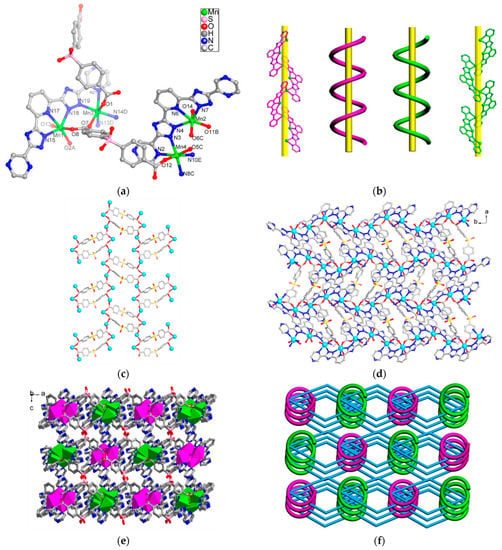
Figure 1.
(a) Local coordination environment of Mn(II) ions in 1. (b) Left- and right-stranded helices constructed from ptptp2− ligands. (c) 2D layer constructed by sdba2− ligands. (d) 2D layer constructed by sdba2− and ptptp2− ligands. (e) Perspective view of 3D supramolecular framework. (f) The simplified sketch of the entire 3D structure.
Interestingly, two kinds of helices in 1 were found within the bonds between the Mn(II) ions and ptptp2− ligands (Figure 1b). Using its central tridentate and terminal bidentate binding sites, each ptptp2− ligand adopt the syn–syn coordination mode (Scheme 1a) and bridge adjacent Mn(II) ions to form charming helical chains with left-handed and right-handed helical rings. The pitch of the left-handed spiral and the right-handed spiral along the b-axis is equal to the length of the b-axis. In the right (Mn-ptptp)n helix, the adjacent Mn…Mn distances are 4.4918(13) Å for Mn4-Mn2 and 4.6183(13) Å for Mn2-Mn4#2, respectively. Moreover, in the left (Mn-ptptp)n helix, the adjacent Mn…Mn distance are 4.5064(14) Å for Mn3-Mn1 and 4.5608(13) Å for Mn1-Mn3#1, respectively.

Scheme 1.
Coordination mode of ptptp2− (1 and 2, for (a)), sdba2− (1, for (b)), and cpop3− (2, for (c)) ligands, color code: C gray, N blue, O red, S yellow, Mn turquoise.
As an important semi-rigid dicarboxylic acid ligand, H2sdba can be considered to be conducive to the preparation of mixed ligand polynuclear complexes [21,22,23]. In 1, all the H2sdba ligands are completely deprotonated and adopt bis-bidentate bridging coordination mode (Scheme 1b). That is to say, each sdba2− ligand acts as a tetra-connector linking four Mn(II) ions. Two Mn atoms are joined by two sdba2− ligands to form a bi-nucleated Mn(II) cluster as a secondary building unit (SBU) with a Mn1⋯Mn3 and Mn2⋯Mn4. These SBUs can be further extended by the carboxylate groups of the sdba2− ligands to give a 2D helix layer (Figure 1c). The interesting feature is that Mn(II) ions in the [Mn6(sdba)2] loops of V-shaped sdba2− ligands are ptptp2− ligands, respectively and 2D layer constructed from sdba2− and ptptp2− ligands (Figure 1d). The adjacent 2D layers are connected by linking to the O–H⋯N hydrogen bonds between the O atoms from water molecules and the N atoms of the pyridine rings, the forces acting between sdba2− form a 3D supramolecular network (Figure 1e). In order to make the structure more intuitive, the left helix of ptptp2− was defined as purple, the right helix was defined as green, the two adjacent sbda2− ligands form a rhombic were defined as light blue, and the simplified sketch of the entire 3D structure is illustrated in Figure 1f.
3.1.2. Crystal Structure of 2
Complex 2 crystallizes in the triclinic space group P-1 and exhibits a 2D 4-connected network based on trinuclear cluster. Each asymmetric unit of 2 contains three Mn(II) ions, one completely deprotonated ptptp2− ligand, one cpop3− anion, and two coordinated water molecules. As shown in Figure 2a, the Mn1 atom is five-coordinated, adopting a distorted trigonal bipyramid geometry via coordinating to three carboxylate oxygen atoms from three cpop3− ligands and two nitrogen atoms from one ptptp2− ligand. Mn2 atom is coordinated by three nitrogen atoms from one ptptp2− ligand, one carboxylate oxygen atom, and two oxygen atoms from two coordinated water molecules to finish a distorted octahedral geometry. Mn3 atom is coordinated by two nitrogen atoms from the only ptptp2− ligand, two carboxylate oxygen atoms from two cpop3− ligands, one bromide ion to finish distorted octahedral geometry. All the Mn−O [range of 2.048(4)− 2.435(4) Å] and Mn−N [range of 2.158(4)− 2.423(5) Å] bond distances are in the normal range [24,25].
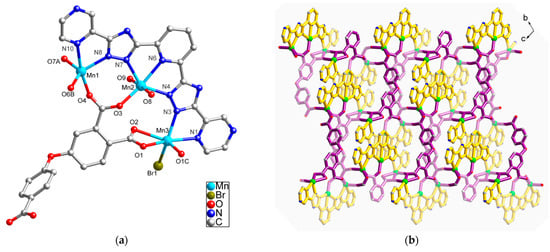
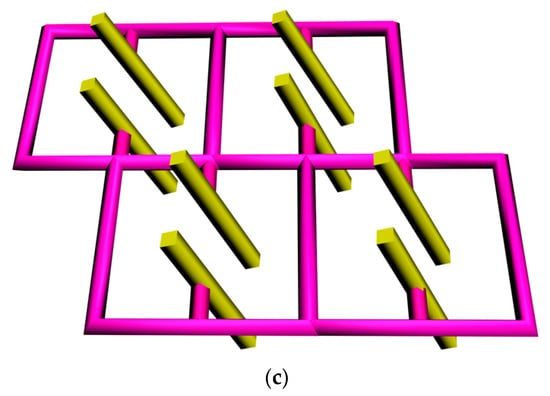
Figure 2.
(a) Local coordination environment of Mn(II) ions in 2. (b) 2D self-threading architecture in 2. (c) Schematic diagram of the 2D self-threading structure, the coordinated ptptp2− ligands like inserted wedges are highlighted by ash blonde.
The completely deprotonated cpop3− ligands in 2 all act as a μ7-bridging, linking six Mn(II) atoms through μ2–η1:η1, μ3–η1:η2, μ2–η1:η1 coordination modes for three carboxylate groups, respectively (Scheme 1c). Three Mn atoms are joined by four cpop3− ligands to form a tri-nucleated Mn(II) cluster as a SBU with Mn1⋯Mn2 and Mn2⋯Mn3 (Figure S1). The distances between adjacent Mn⋯Mn are 4.4131(19) Å for Mn1–Mn2 and 4.5425(19) Å for Mn2–Mn3. The neighbouring trinuclear Mn(II) clusters are actually linked by V-shaped cpop3− ligand spacers to give a 2D layer. The dangling ptptp2− ligand grafted on the trinuclear Mn(II) clusters crosses over the rhombic cavity in the two-dimensional layer. Each rhombic window is penetrated by two ptptp2− ligands belonging to the two-dimensional layer itself, as shown in Figure 2b. A schematic illustration of the two-dimensional self-threading structure is presented in Figure 2c.
3.2. Powder X-Ray Diffraction (PXRD) and Thermal Analyses
The powder X-ray diffraction (PXRD) pattern of 1 and 2 were checked at room temperature. To present more clearly for a proper judgement of the phase purity, we narrowed the 2theta range (5–40 deg) to display relevant data only. As shown in Figure 3a,b, the experimental PXRD spectrum is consistent with the simulated PXRD spectrum, showing good phase purity of 1 and 2. It should be noted that the PXRD pattern of 1 must been measured with a freshly prepared sample. When the sample is placed in the air for more than 14 days, the crystallinity of 1 will deteriorate (Figure S2). In order to fully characterize the thermal stability of the complexes, their thermal behaviors in dry nitrogen atmosphere were studied by thermogravimetric analysis (TGA) from 30 to 800 °C. As shown in Figure 3c, a first weight loss of 3.9% occurs from 98 to 170 °C, which corresponds to the loss of coordinated and guest water molecules (calcd: 4.4 %). The main framework of 1 begun to collapse since about 466.0 °C. Further heating to 800 °C indicates a slow weight loss of residue and final residue (22.6%). The last weight loss of 1.8% is observed. 2 begins to collapse from about 156.8 °C, and an initial weight loss of 6.9% is observed, corresponding to the release of coordinated and guest water molecules (calculated, 7.5%). The main framework of 2 begun to collapse at about 418.6 °C. Further heating to 800 °C indicates a slow weight loss of residue and final residue (24.8%).
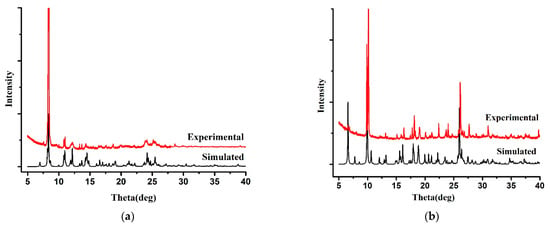
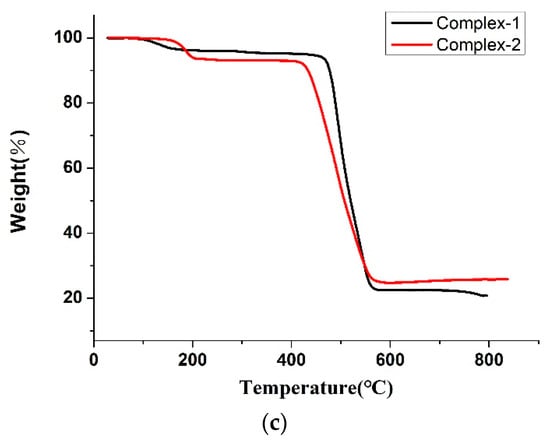
Figure 3.
Simulated and experimental PXRD pattern of 1 (a) and 2 (b). Thermogravimetric (TG) analysis curve of 1 and 2 (c).
3.3. Magnetic Properties
In the 2–300 K temperature range, the magnetic susceptibilities of 1 and 2 were measured. The plots of χM and 1/χM vs. T are shown in Figure 4. For 1, the experimental χMT values at room temperature is 16.66 cm3 K mol−1 (μeff = 5.77 μB), which is lower than the pure spin value 17.52 cm3 K mol−1 (μeff = 5.92 μB and with g = 2.0) of four magnetically isolated high spin Mn (II) ions. The 2D structure of 1 was through the use of sdba2− ligands to link the 1D Mn(II) ion chains. In general, sdba2− can form a very weak coupling, so the magnetic behavior shows the characteristics of a one-dimensional chain, the connection mode between Mn(II) ions is carboxylate bridges and [ptptp]2−-N,N bridges. For 2, the experimental χMT at room temperature is 4.37 cm3 K mol−1 (μeff = 5.91 μB), which is equivalent to the spin only value 4.38 cm3 K mol−1 (μeff = 5.92 μB and with g = 2.0) expected for a magnetically isolated high spin Mn(II) ion. The gradual decrease trend of the χMT as the temperature lowing indubitably indicate the antiferromagnetic interactions in 2. Similar to 1, the 2D structure of 2 was through the use of cpop3- ligands to link the 1D Mn(II) ions chains.
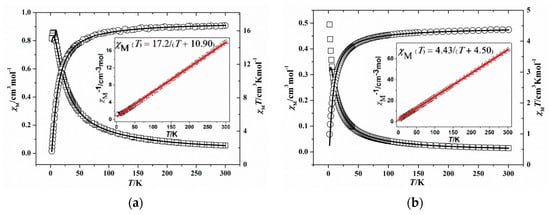
Figure 4.
Plots of χMT (☐) and χM (◯) versus T for complex 1 (a) and 2 (b). Inset: the red line represent the best fit of 1/χM based on Curie-Weiss law in 2−300 K temperature range for complex 1 and 2, respectively.
In the reciprocal susceptibilities (1/χM) versus temperature (T) plot (inset in Figure 4), the observed susceptibility data above 10 K were well-fitted by Curie-Weiss law, yielding Cm = 17.2 cm3 K mol−1, θ = −10.90 K and R = 1.29 × 10−4 for 1, and Cm = 4.43 cm3 K mol−1, θ = −4.50 K and R = 2.29 × 10−4 for 2. The negative θ value indicated the presence of weak intrachain antiferromagnetic exchange in complex 1 and 2.
From a magnetic point of view, 1 and 2 can be regarded as a 1D Mn(II) ion chain. The magnetic exchange pathway in the 1D chain can be considered as a magnetic two Mn(II) chain with the periodic –J1J2J1J2– coupling sequence. To estimate the magnitude of the antiferromagnetic coupling, the magnetic susceptibility data were fitted according to the spin-exchange Hamiltonian for the alternating chains in 1 and 2, as follows: . The magnetic susceptibility equation of this dimer system is as follows [26]:
u1 = coth[J1/kT] − kT/J1
u2 = coth[J2/kT] − kT/J2
The best fitting parameters obtained were J1 = −0.45, J2 = −1.42, g = 1.98, and R = 3.23 × 10−3 for 1, and J1 = −0.45, J2 = −0.81, g = 2.01, and R = 3.59 × 10−4 for 2 in the 2–300 K temperature range.
4. Conclusions
Two poly-nucleated Mn(II) cluster complexes 1 and 2 with the ligand 2-(5-{6-[5-(Pyrazin-2-yl)-1H-1,2,4-triazol-3-yl]pyridin-2-yl}-1H-1,2,4-triazol-3-yl)pyrazine (H2ptptp) and V-shaped bicarboxylate ligand H2sdba or tricarboxylate ligand H3cpop, respectively, have been synthesized using [BMI]Br ILs as the medium for the preparation. The structure feature of 1 is that Mn(II) ions in the [Mn6(sdba)2] loops of V-shaped sdba2− ligands are ptptp2− ligands, respectively and 2D layer is constructed from sdba2− and ptptp2− ligands. The adjacent 2D layers are connected by O–H⋯N hydrogen bonds to form a 3D supramolecular network. The neighbouring trinuclear Mn(II) clusters in 2 are actually linked by V-shaped cpop3− ligand spacers to give a 2D layer, which is penetrated by ptptp2− ligands to form a self-threading structure. The results of variable temperature magnetic studies show that the magnetic interactions between the Mn(II) ions in 1 and 2 are mainly due to antiferromagnetic coupling.
Supplementary Materials
The following supporting information can be downloaded at: https://www.mdpi.com/article/10.3390/cryst12020278/s1. Table S1: Selected bond lengths (Å) and bond angles (o) for 1–2, Figure S1: The 4-connected network and tri-nucleated Mn(II) cluster of complex 2. Figure S2: Simulated and experimental PXRD pattern of 1 placed in the air for more than 14 days.
Author Contributions
H.W. synthesized the two compounds. J.Q. performed the X-ray structure determination. H.W. analyzed the results and wrote the paper. All authors have read and agreed to the published version of the manuscript.
Funding
This research received no external funding.
Institutional Review Board Statement
Not applicable.
Informed Consent Statement
Not applicable.
Data Availability Statement
Crystallographic crystal data can be obtained free of charge via http://www.ccdc.cam.ac.uk/conts/retrieving.html, or from the Cambridge Crystallographic Data Centre, 12 Union Road, Cambridge CB2 1EZ, UK; fax: (+44) 1223-336-033; or e-mail: deposit@ccdc.cam.ac.uk.
Acknowledgments
This work was supported by the National Natural Science Foundation of China (No. 21971100), and the Key Scientific Research Projects of Higher Education of Henan Province (No. 20A150005).
Conflicts of Interest
The authors declare no conflict of interest.
References
- Nishihara, H. Coordination programming: A new concept for the creation of multifunctional molecular systems. Chem. Lett. 2014, 43, 388–395. [Google Scholar] [CrossRef] [Green Version]
- Han, S.-D.; Liu, A.-J.; Wei, Q.; Hu, J.-X.; Pan, J.; Wang, G.-M. Quadruple photoresponsive functionality in a crystalline hybrid material: Photochromism, photomodulated fluorescence, magnetism and nonlinear optical properties. Chem. Eur. J. 2021, 27, 7842–7846. [Google Scholar] [CrossRef] [PubMed]
- Xu, M.-Y.; Wang, Y.-T.; Ni, Q.-L.; Zhang, Z.-H.; Wang, X.-J.; Liang, G.-M.; Gui, L.-C. Aggregation of the metallocycles {Cu8} and {Cu20} using [Cu(bp)] units (H2bp = bis(2-hydroxybenzyl)amine): Structures and magnetic properties. Dalton Trans. 2016, 45, 4993–4997. [Google Scholar] [CrossRef] [PubMed]
- Dutta, S.; Ghosh, T.; Mahapatra, P.; Ghosh, A. Joining of trinuclear heterometallic CuII2–MII (M = Mn, Cd) nodes by nicotinate to form 1D chains: Magnetic properties and catalytic activities. Inorg. Chem. 2020, 59, 14989–15003. [Google Scholar] [CrossRef] [PubMed]
- Yang, X.-G.; Ma, L.-F.; Yan, D.-P. Facile synthesis of 1D organic—Inorganic perovskite micro-belts with high water stability for sensing and photonic applications. Chem. Sci. 2019, 10, 4567–4572. [Google Scholar] [CrossRef] [PubMed] [Green Version]
- Saadaoui, I.; Krichen, F.; Salah, B.; Mansour, R.; Miled, N.; Bougatef, A.; Kossentini, M. Design, synthesis and biological evaluation of Schiff bases of 4-amino-1,2,4-triazole derivatives as potent angiotensin converting enzyme inhibitors and antioxidant activities. J. Mol. Struct. 2019, 1180, 344–354. [Google Scholar] [CrossRef]
- Zafar, W.; Sumrra, S.H.; Chohan, Z.H. A review: Pharmacological aspects of metal based 1,2,4-triazole derived Schiff bases. Eur. J. Med. Chem. 2021, 222, 113602. [Google Scholar] [CrossRef]
- Sumrra, S.H.; Zafar, W.; Javed, H.; Zafar, M.; Hussain, M.Z.; Imran, M.; Nadeem, M.A. Facile synthesis, spectroscopic evaluation and antimicrobial screening of metal endowed triazole compounds. Biometals 2021, 34, 1329–1351. [Google Scholar] [CrossRef]
- Haasnoot, J.G. Mononuclear, oligonuclear and polynuclear metal coordination compounds with 1,2,4-triazole derivatives as ligands. Coord. Chem. Rev. 2000, 200, 131–185. [Google Scholar] [CrossRef]
- Naik, A.D.; Dirtu, M.M.; Railliet, A.P.; Marchand-Brynaert, J.; Garcia, Y. Coordination polymers and metal organic frameworks derived from 1,2,4-triazole amino acid linkers. Polymers 2011, 3, 1750–1775. [Google Scholar] [CrossRef] [Green Version]
- Wang, X.-L.; Gong, C.-H.; Zhang, J.-W.; Liu, G.-C.; Kan, X.-M.; Xu, N. Polyoxometalate-directed assembly of various multinuclear metal–organic complexes with 4-amino-1,2,4-triazole and selective photocatalysis for organic dye degradation. CrystEngComm 2015, 17, 4179–4189. [Google Scholar] [CrossRef]
- Feltham, H.L.C.; Barltrop, A.S.; Brooker, S. Spin crossover in iron(II) complexes of 3,4,5-tri-substituted-1,2,4-triazole (Rdpt), 3,5-di-substituted-1,2,4-triazolate (dpt-), and related ligands. Coord. Chem. Rev. 2017, 344, 26–53. [Google Scholar] [CrossRef]
- Jia, Y.; Li, H.; Zhao, B.; Guo, Q.; Hou, H.; Fan, Y. The syntheses, crystal structure, and exceptional chemical stability of three multinuclear PbII complexes. Eur. J. Inorg. Chem. 2013, 2013, 438–445. [Google Scholar] [CrossRef]
- Du, D.-Y.; Qin, J.-S.; Sun, C.-X.; Wang, X.-L.; Zhang, S.-R.; Shen, P.; Li, S.-L.; Su, Z.-M.; Lan, Y.-Q. Functional heterometallic coordination polymers with metalloligands as tunable luminescent crystalline materials. J. Mater. Chem. 2012, 22, 19673–19678. [Google Scholar] [CrossRef]
- Qin, J.-H.; Zhang, H.; Sun, P.; Huang, Y.-D.; Shen, Q.; Yang, X.-G.; Ma, L.-F. Ionic liquid induced highly dense assembly of porphyrin in MOF nanosheets for photodynamic therapy. Dalton Trans. 2020, 49, 17772–17778. [Google Scholar] [CrossRef]
- Kharissova, O.V.; Kharisov, B.I.; Gonzalez, C.M.O.; Méndez, Y.P.; Lopez, I. Greener synthesis of chemical compounds and materials. R. Soc. Open Sci. 2019, 6, 191378. [Google Scholar] [CrossRef] [Green Version]
- Qin, J.-H.; Jia, Y.; Li, H.; Zhao, B.; Wu, D.; Zang, S.-Q.; Hou, H.; Fan, Y. Conversion from a heterochiral [2 + 2] Coaxially nested double-helical column to a cationic spiral staircase stimulated by an ionic liquid anion. Inorg. Chem. 2014, 53, 685–687. [Google Scholar] [CrossRef]
- Qin, J.-H.; Wang, H.-R.; Pan, Q.; Zang, S.-Q.; Hou, H.; Fan, Y. Influence of ionic liquids on the syntheses and structures of Mn(II) coordination polymers based on multidentate N-heterocyclic aromatic ligands and bridging carboxylate ligands. Dalton Trans. 2015, 44, 17639–17651. [Google Scholar] [CrossRef]
- Dolomanov, O.V.; Bourhis, L.J.; Gildea, R.J.; Howard, J.A.K.; Puschmann, H. OLEX2: A complete structure solution, refinement and analysis program. J. Appl. Cryst. 2009, 42, 342–346. [Google Scholar] [CrossRef]
- Sheldrick, G.M. Crystal structure refinement with SHELXL. Acta Cryst. 2015, 71, 3–8. [Google Scholar]
- Bu, Y.; Jiang, F.; Zhou, K.; Gai, Y.; Hong, M. From 3D interpenetrated polythreading to 3D non-interpenetrated polythreading: SBU modulation in a dual-ligand system. CrystEngComm 2014, 16, 1249–1252. [Google Scholar] [CrossRef]
- Chen, Y.Q.; Tian, Y.; Li, N.; Liu, S.J. Ni(II)/Zn(II)-triazolate clusters based MOFs constructed from a V-shaped dicarboxylate ligand: Magnetic properties and phosphate sensing. J. Solid State Chem. 2018, 262, 100–105. [Google Scholar] [CrossRef]
- Zhu, Z.Z.; Tian, C.B.; Sun, Q.F. Coordination-assembled molecular cages with metal cluster nodes. Chem. Rec. 2021, 21, 498–522. [Google Scholar] [CrossRef] [PubMed]
- Sato, H.; Yamaguchi, M.; Onuki, T.; Noguchi, M.; Newton, G.N.; Shiga, T.; Oshio, H. Pentanuclear and octanuclear manganese helices. Eur. J. Inorg. Chem. 2015, 2015, 2193–2198. [Google Scholar] [CrossRef]
- Li, J.X.; Xiong, L.Y.; Fu, L.L.; Bo, W.B.; Du, Z.X.; Feng, X. Structural diversity of Mn(II) and Cu(II) complexes based on 2-carboxyphenoxyacetate linker: Syntheses, conformation comparison and magnetic properties. J. Solid State Chem. 2022, 305, 122636. [Google Scholar] [CrossRef]
- Cortés, R.; Drillon, M.; Solans, X.; Lezama, L.; Rojo, T. Alternating ferromagnetic−Antiferromagnetic interactions in a manganese(II)−Azido one-dimensional compound: [Mn(bipy)(N3)2]. Inorg. Chem. 1997, 36, 677–683. [Google Scholar] [CrossRef]
Publisher’s Note: MDPI stays neutral with regard to jurisdictional claims in published maps and institutional affiliations. |
© 2022 by the authors. Licensee MDPI, Basel, Switzerland. This article is an open access article distributed under the terms and conditions of the Creative Commons Attribution (CC BY) license (https://creativecommons.org/licenses/by/4.0/).